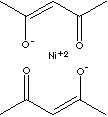PRODUCT IDENTIFICATION

H.S. CODE
TOXICITY
CLASSIFICATION
METAL ACETYLACETONATES /
PHYSICAL AND CHEMICAL PROPERTIES
MELTING POINT
SOLUBILITY IN WATER
soluble
REFRACTIVE INDEX
GENERAL DESCRIPTION & APPLICATIONS
Acetoacetone is a beta-diketone (1,3-diketone) which two ketones are separated only by one carbon. The beta-ketone is stable as a conjugated enol rather than alpha-diketone due to the delocalization which makes the counterion more stable and less likely to regain the proton. Ascorbic acid is an example of enol compound. Enol compounds form complexes with many transition metal ions. These compounds are readily soluble in organic solvents. They are widely used as chelating agents, ligands, and catalyst precursors.
Acetoacetic acid and its esters contain active methylene groups which have relatively acidic alpha-protons due to H atom adjacent to two carbonyl groups. The reactivity of its methylene group provide the sequence of reactions of alkylation, hydrolysis of the esters and decarboxylation resulting in substituted ketones. The methylene group can be reacted to form amino-carbonyl compounds. Acetoacetates are important aliphatic parts adjoining azo dyes and pigments. Acetoacetic acid is unstable and decompose to acetone and carbon dioxide at room temperature. Aacetoacetate is one of ketone bodies which are the end-products of rapid or excessive fatty acid breakdown in the human body.
Para-benzoquinone and its derivatives belong to 1,4-diketone family. Benzoquinone is used as an oxidizing agent in organic chemistry and is a common constituent of biologically molecules like Vitamin K1. Quinones serves as electron acceptors in electron transport chains such as in photosynthesis, and aerobic respiration.
Diketene derivatives find versatile applications in making biomolecules, agrochemicals, dyes, pigments, pharmaceuticals including vitamins, and stabilizers for PVC and polyester. They are used as components for fragrances and as solvents. Diketones undergo the reversible and irreversible addition reactions include;
- Aldol Reactions
- Alkylation of Enolate Anions
- Clemmensen Reduction
- Cyanohydrin Formation
- Enamine Formation
- Hemiacetal and Acetal Formation
- Hydration Formation
- Imine Formation
- Wolff-Kishner Reduction
Acetylacetone (2,4-pentanedione) is a clear to slightly yellowish liquid; melting point –23 C, boiling point 139 C. It is readily soluble in water and in organic solvents. The keto form (CH2COCH2COCH3) and enol form (CH3COCH=C(OH)CH3) coexist in solution. This enol-keto tautomerism (reversible interconversion of structural isomers) results in the tautomeric migration of a hydrogen atom from an adjacent carbon atom to a carbonyl group of a keto compound to produce the enol form of the compound; the reverse migration of hydrogen atom is also interconvertible, which makes the switch of a single bond and adjacent solid bond.
Acetylacetone is used in the production of anti-corrosion agents and its peroxide compounds for the radical initiator application for polymerisation. It is used as a chemical intermediate for drugs (such as sulfamethazine, nicarbazine, vitamin B6 and vitamin K) and pesticides (such as sulfonylurea herbicides). Very strong bases can deprotonate two carbonyl groups and results in alkylation at C1. Arylation can be obtained by substitution of halides on benzoic acid. Acetylacetone is converted to heterocycles (isoxazoles, pyrazoles,pyrimidines, pyridines etc); to pyrazoles with hydrazine and to pyrimidines with urea. Acetylacetone condenses with amines to give diketimines. It is used as a solvent for cellulose acetate, as an additive in gasoline and lubricant, as a dryer of paint and varnish. It is used as an indicator for the complexometric titration of Fe(III) and for the modification of guanidino groups and amino groups in proteins.
Acetylacetone is used in the preparation of metal acetylacetonates for catalyst application. The oxygen atoms in delocalized anion (acetylacetonate) left after the removal of a proton from an enol is readily bound to transition metal ions and form chelate complexes which is freely soluble organic solvents, in contrast to the related metal halides. Metal acetylacetonate complexes are widely used as catalysts and reagents.
Copper(II) acetylacetonate catalyzes coupling and carbene transfer reactions. Copper(I) acetylacetonate employed to catalyze Michael additions. Metal acetylacetonates are used as catalysts for polymerization of olefins and transesterification. They are used as PVC stabilizer. They are used as curing agents for epoxy resins, acrylic adhesives and silicone rubbers. They are used as solvents, lubricant additives, paint drier, and pesticides. They are used in glass coatings.APPEARANCE
PURITY
98.0% min